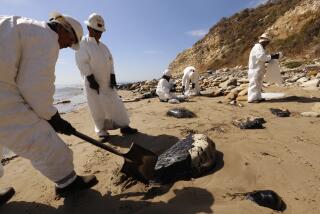Not-So-Merry Chase to Save Poisoned Birds : Santa Clara River: The living victims of an oil spill flee from state fish and game workers. But 110 are rescued. Sixty are found dead.
- Share via
Inside a cardboard box, an oil-drenched mallard was perched on a bed of towels.
The mallard had given a bird rescue worker a good chase along the shoreline of the Santa Clara River before being caught. Unable to swim because of the oil, it would have almost certainly died if it had not been found, rescue workers said.
The mallard was one of 110 birds rescued since a ruptured Mobil Oil Corp. pipeline spilled heavy crude oil into the Santa Clara River Friday, according to state Department of Fish and Game estimates.
Sixty other birds have been found dead.
The live birds are often found emaciated from ingesting the crude oil and unable to fly because the sticky substance weighs them down, fish and game department officers said.
“There are toxic effects from the oil,” Capt. Roger Reese said. “We’re not catching healthy critters.”
Oil sticks to bird feathers, causing them to pull apart and damaging the species’ natural buoyancy, waterproof capability and insulation, said Mimi Wood of the International Bird Rescue Research Center, a Berkeley-based organization hired by Mobil to rescue and clean the birds.
“The natural alignment of the feathers prevents them from getting wet and cold,” Wood said.
As the birds use their beaks to try to pull the oil off their feathers, they end up ingesting the oil, which can cause severe damage to internal organs, rescue workers said.
The rescue process, however, is not without its share of trials. The birds flee at the sight of the hulking humans in rain slickers, wading boots and long, yellow rubber gloves.
“They think we’re mean. We go out and invade their homestead. We grab them,” said Jon Holmes, a member of the California Conservation Corps.
Rescue workers and Conservation Corps members have been edging downstream along the eight-mile slick from Valencia toward Piru during the past week in search of injured birds.
The crews work under the supervision of the fish and game department. A crew of seven worked recently in a marshy area of Ventura County along the Santa Clara River, about five miles from the Los Angeles County line. This site is a prime feeding area for the birds, Jay Holcomb, director of International Bird Rescue, said. The majority of those found are mallards and American widgeons. Some birds are easier to rescue than others, Holcomb said.
“Ducks are easier to catch. Coots are hard because they run real fast and can get away easier. They hide in the bushes, and they are mean. They bite and kick,” Holcomb said.
Despite the attempts of fish and game officers to scare unfouled birds away from the river, new birds dive into the oily surface every day, Holcomb said. “They don’t know any better,” he said.
Rescue workers transport the birds in cardboard boxes from the river to a command post set up near the site of the spill in Valencia and then feed them a rehydrating solution that flushes the oil toxins out.
The birds are then taken to a shelter on Terminal Island in Los Angeles. Two trips are made daily from the site to the shelter.
At the shelter, the birds spend one to two days in wooden pens with other birds, Wood said. Birds of a more combative nature such as great blue herons and Cooper’s hawks are housed individually.
After a series of blood tests, temperature checks and weighings, the birds are cleansed in small washtubs with 1% dish-washing liquid solution in water kept at 110 degrees. The entire process--from wash to rinse--takes about 40 minutes, Wood said.
The birds are then left to dry under a pet dryer before they are tested for buoyancy and waterproofing in miniature swimming pools. If they can swim without becoming wet, the birds are allowed to move to outside pens equipped with the pools.
None of the birds have been released yet from the shelter, and none are expected to be released for at least another week, Wood said. She said rescue workers have not yet decided where the birds will be set free.
Between 40% to 50% of the estimated 75,000 gallons of oil that leaked from an 18-inch-long pipeline crack near the Valencia Golf Course has been recovered, a Mobil spokesman said. The cleanup, which is estimated to cost between $1 million to $2 million, is expected to take between one to two months. The spokesman had no estimate for the costs of rescuing and cleaning the birds.
Meanwhile, rescue workers say the birds are hardy survivors. Nevertheless, they realize that there are plenty of birds that might never be rescued and will subsequently die in the wild. “There are a lot of birds out there. But we can’t catch all of them,” Holcomb said.
More to Read
Sign up for Essential California
The most important California stories and recommendations in your inbox every morning.
You may occasionally receive promotional content from the Los Angeles Times.










